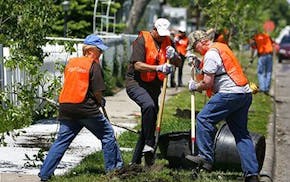State health officials declared Tuesday that the H1N1 outbreak has passed its peak in Minnesota, at least for this wave, and said they have downgraded the level of flu activity from "widespread" to "regional," meaning that fewer than half the regions in the state have rising levels of flu-like illness.
"We may well have another several weeks of activity," said State Epidemiologist Ruth Lynfield. "But it is fair to say that we have peaked -- as long as everyone takes good precautions over Thanksgiving."
Officials also said that more than a third of the estimated 2.7 million Minnesotans considered to be at high risk from flu have been vaccinated or will be this week.
Tuesday they expanded the list of high-priority groups eligible to receive vaccine to include everyone between the ages of 6 months to 24 years, even healthy people. They also added adults ages 24 through 65 with chronic health conditions.
That does not mean there is now enough vaccine for all 2.7 million people considered to be at high risk for flu complications, said Kris Ehresmann, director of the state's vaccine program. But there will be in the coming weeks.
As vaccine arrives, it will be made available to those in the expanded group at public vaccine clinics and medical clinics that provide it to their patients.
Healthy adults will probably not get the vaccine line until sometime in January, but health officials said they hope to eventually immunize about 5.4 million people in all.
Meanwhile last week:
•The number of people hospitalized with confirmed H1N1 cases dropped from 78 to 29. Since Sept. 1 there have been 1,507 confirmed novel H1N1 influenza hospitalizations.
•However, the number of flu-related deaths remained high -- 6 confirmed as H1N1 and one probable. But that is a lagging indicator of flu activity; it takes several weeks to complete laboratory testing on fatalities, health officials said.
In all, there have been 32 confirmed and three probable H1N1 deaths since the virus first appeared in the state last spring.
•Flu outbreaks in schools and cases reported by the state's "sentinel" clinics remained far below peak levels of early fall. Even so, Lynfield cautioned against complacency about flu.
The H1N1 outbreak could easily turn around again, she said, and seasonal flu is on its way. The first cases of seasonal flu usually start appearing in December or January in Minnesota, she said. And there could be a third wave of H1N1 in January or February. That is why health officials are still strongly encouraging those at high risk to get a vaccine.
On Nov. 30, the state Health Department will begin posting a list of H1N1 vaccine clinics on its website, a service it provides every year for seasonal flu-shot clinics.
Those seeking vaccine can also check with their health care providers or local health departments.
A list of local public health agencies is available on the Health Department website at tinyurl.com/ybwxdnc.
Who can get shots now
The list of high priority groups for H1N1 vaccine now includes:
•Those age 6 months through 24 years, with or without a health condition.
•Those age 25 through 64 with a chronic medical condition.
•Pregnant women.
•Health care providers or emergency medical services personnel.
•Those living with or caring for children younger than 6 months.
Josephine Marcotty • 612-673-7394

Yuen: Why do people forgive? It's messy, complex and 'the best form of self-interest'

Hark, downtown Minneapolis' only vegan, gluten-free cafe, closing April 28

Critics' picks: The 12 best things to do and see in the Twin Cities this week
How the Goo Goo Dolls learned the music biz from Minneapolis bands

